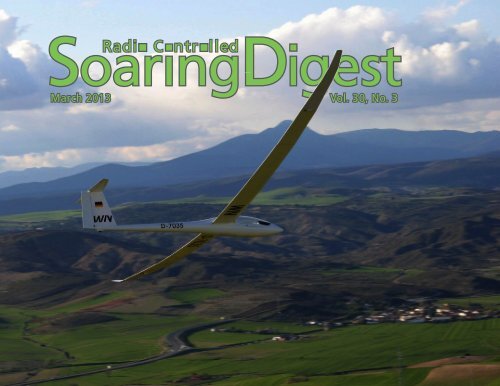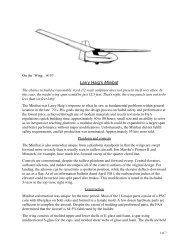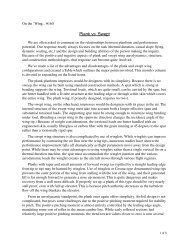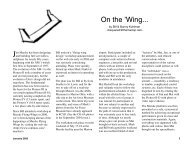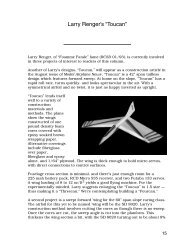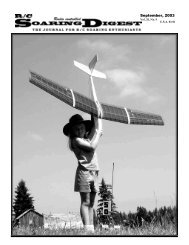RCSD-2013-03 - Rcsoaring.com
RCSD-2013-03 - Rcsoaring.com
RCSD-2013-03 - Rcsoaring.com
- No tags were found...
You also want an ePaper? Increase the reach of your titles
YUMPU automatically turns print PDFs into web optimized ePapers that Google loves.
SoaringDigestRadi C ntr lledMarch <strong>2013</strong> Vol. 30, No. 3
CONTENTSMarch <strong>2013</strong>Vol. 30, No. 33 RC Soaring Digest Editorial4 TOSS Aerobatics Event <strong>2013</strong>Kevin Farr provides coverage of this annual event heldin Cape Town, South Africa. This year saw excellentweather for the two day <strong>com</strong>petition. Photos by KevinFarr, Alan Ball and Dave Lentil. Alan Ball’s video can beviewed at .NASA Tech Briefs24 Research Paves Way for Larger, SaferLithium Ion BatteriesFront cover: José Carrion performs a close fly-bywith his 7 meter home made Nimbus 4 at La Muela,near Madrid, Spain. Photo by Pierre RondelCanon EOS 10D, ISO 400, 1/750 Sec., f6.7, 65mmSnow Flying 25Dave Garwood and Steve Mintz brave the weatherand discover something about radio waves.Monte Cucco Slope Meeting 28Cesare de Robertis, Editorial Director, Modellismo,and photographer Fabio Fasciani provide detailedcoverage of this well organized event which drew86 participants for four days of spectacular flying.Product ReviewHakko FX-888 Soldering Station 46and FX-8801 Soldering IronAccurate temperature control and a sturdy and<strong>com</strong>fortable feel — a near professional class unitat an affordable price.Back cover: Miniature stick models are often used innon-flying practice sessions to mimic the planned aerobatic<strong>com</strong>petition maneuvers. Kevin Farr captured this one at restat the TOSS Aerobatic Event in late January of this year. Fullcoverage of that event begins on page 4 of this issue.Panasonic DMC-FZ100, ISO 100, 1/640 sec., f4.0, 50mm2 R/C Soaring Digest
R/C Soaring DigestMarch <strong>2013</strong>Volume 30 Number 3Managing Editors, PublishersContactB 2 Kuhlmanrcsdigest@centurytel.nethttp://www.rcsoaringdigest.<strong>com</strong>Yahoo! group: RCSoaringDigestR/C Soaring Digest (<strong>RCSD</strong>) is a reader-written monthlypublication for the R/C sailplane enthusiast and has beenpublished since January 1984. It is dedicated to sharingtechnical and educational information. All material contributedmust be original and not infringe upon the copyrights of others.It is the policy of <strong>RCSD</strong> to provide accurate information.Please let us know of any error that significantly affects themeaning of a story. Because we encourage new ideas, thecontent of each article is the opinion of the author and may notnecessarily reflect those of <strong>RCSD</strong>. We encourage anyone whowishes to obtain additional information to contact the author.———Copyright © <strong>2013</strong> R/C Soaring DigestPublished by B2Streamlines P.O. Box 975, Olalla WA 98359All rights reserved———RC Soaring Digest is published using Adobe InDesign CS6In the AirWe received a note from Dave Garwood regardingelectrifying the Dream-Flight Alula Evo, too late for theFebruary issue which carried Dave's kit review. Davereceived a request from Umberto Rossi concerning aproject of this kind and Dave responded with the followinglinks:E-lula Electrified Alula Thread - RC Groups:Electrified Alula videos:There are, of course, also relevant threads on RCGroups,with at least two general threads on the Alula which aremore than 100 pages in length.The article on Li-ion batteries which appears in this issue,page 24, <strong>com</strong>es from Tech Briefs, a NASA publication. Wehope it will be an enlightening read and would appreciatefeedback, positive or negative, as to whether similararticles would be appropriate for future issues of RCSoaring Digest.Time to build another sailplane!March <strong>2013</strong> 3
Two Oceans Slope SoarersTOSS AEROBATICEVENT <strong>2013</strong>Kevin Farr, kevin@fvdv.co.zaphotos by Kevin Farr and Alan Ball4 R/C Soaring Digest
Five Years! Five long years, that’s how long we have been waiting forthat near perfect event. For the event that has wind all weekend, fromthe right direction, consistent for more than a few hours at a time, andfor more than one day at a time. And so the slope pixies came to ouraid and delivered just that. The perfect slope precision aerobaticschallenge, hours in the sun and a herculean call for consistency, as itappeared Mother Nature was not going to let up on us with all of theelements gathered in a heady mixture.And so, on a breezy clear Saturday morning, the 26th of January<strong>2013</strong>, a record field of 23 entrants gathered up on Red Hill aboveSimonstown, Cape Town, South Africa.After a meet and greet the previous evening that had seen all andsundry gather at the local watering hole to quaff beer, wine andwhile away an hour or two, 13 nervous Sportsman’s Class and 10apprehensive Expert Class entrants took in the pilot briefing andsafety tips. Again the TOSS <strong>com</strong>mittee had out done itself and thepreparations were at the ready. A mass of wings, booms, humans andtails made their way down to the flight-line amid chattering banter.After a short Judges briefing to ascertain that all four Judges were infact on the same page, in the same place and at the same time, thefirst of the brave souls stepped up to the flight-line and took on thechallenge in perfect South East conditions. For those not familiar withthe format, two pilots are airborne at any given time.There are two more nervous individuals in the ready box, being...well ready, and then a third set of contestants aware of their placein the queue and gearing up as Uncle Bill, Safety Officer, yelledthe <strong>com</strong>mands and called out their names in a no nonsense sortof a way. The routine is simple. Six statutory manoeuvres, andfour optional with each finger testing manoeuvre to be performedsingularly.March <strong>2013</strong> 5
Two Oceans Slope SoarersThe Durban Crew6 R/C Soaring Digest
Enter the box, do your three rolls, find the centre line, find thehorizon, <strong>com</strong>plete the manoeuvre and leave the box. Nextcontestant to do the same, then onto the next manoeuvre untilall six statutory moves are <strong>com</strong>plete, then you do your optionalsbased on the same idea, and hence <strong>com</strong>plete a round.Now the ready box is about the scariest place on earth. Onceyou have stepped to the flight-line your fate is in your hands,literally, but sitting in that box is about as nerve wracking as itgets, but does also help you to focus very sharply on the taskon hand.Enter to <strong>com</strong>batants in Sportsman’s class and there were somewho took to it like ducks to water, opened up a substantial gapin the first round, and were able to defend from there on.Notable at this stage would be Jacque du Toit, who sufferedlock-out on his glider before the contest had even started. Theresulting loss of his Toucan to an untimely impact left him withonly one option. Simply borrow another contestant’s glider andwithout hesitation continue to <strong>com</strong>pete for the rest of the day,and the following one as well.The expert class were next to <strong>com</strong>pete their schedule andshowed signs of brilliance and as the duels intensified,realisation filled the air that once more the <strong>com</strong>petitionhad improved, intensified, and that the entire field wouldbe separated by no more than a camel hair by the end ofproceedings.Round one in the bag!Without so much as a break between rounds, it was deemedsafer to reverse the classes and put up the Expert class first,as conditions did show signs of going a bit South and wreckingthe whole affair.Deteriorate it did, not to the point of being un-flyable, but justnot as great as it was in the first round. And blow me downwith a glider in hand, if the entire set of contestants didn’tjust step up the ante a whole bunch. More time was taken togain altitude, manoeuvres were more considered, accurateand centered, with the scores from the judges climbing inappreciation of this. Thanks to our Contest Director Jeff Steffenfor calling this one correct. Only notable mishap was MarcWolffe’s glider exploding midair as the center wing panel gaveway folding like a tissue and taking him out of the contest dueIn the pits, Kevin and Louis about to <strong>com</strong>mence the round.March <strong>2013</strong> 7
Two Oceans Slope SoarersMalcolm Riley Launches the Dorado8 R/C Soaring Digest
to lack of any distinguishable part of theglider. As conditions once again gainedmomentum, then switched back to SouthEast, the Sportsman’s Class took tothe air, flew through the round gainingconfidence all the time and setting thebar even higher for those that will dothis for the first time next year. Finalpairs were up at 4:00 in the afternoon<strong>com</strong>pleting a long slope day no matterhow you looked at it.Round 2 in the bag!Back to the watering hole, mealstaken in, and a raft of weary sunburntcontestants made for bed and dreams ofmore of the same.Overnight, in the wee hours and with theaid of sucker sticks, epoxy and a vacuumbag, Alan Ball and Ryan Matchetttinkered away to make good Alan’s gliderwing for the next day. Michel Leuschthrew in a new servo on his aileron due tofailure, and Christo Le Roux added halfa soda can to his leading edge coveringsome nasty twig damage, such was the<strong>com</strong>mitment to make good and be partof the final day of the event. Wind ornone, the contestants were going to beready!And this is where the plot changes fromall the previous years.Cue an exact replica of the day before.Perfect South East. 30-40 kilometresan hour caressing the slope with hugeamounts of lift grabbing gliders rightRussel Conradt launches another gliderout of the hand on launch. Up steppedthe Sportsman’s Class, with nerves farmore settled and everyone aware of theirroles and requirements, we were ableto whizz our way through the round. Airbattles raged royal between contestantsas was seen between Dean Halley andMarch <strong>2013</strong> 9
Two Oceans Slope Soarers10 R/C Soaring Digest
How we got some of the footage used in the videoMarch <strong>2013</strong> 11
Two Oceans Slope Soarers12 R/C Soaring Digest
Jeff Steffen, with Jeff taking an ill timedsnap into the bushes below, racing downthe hill to collect the glider, racing backup the hill and managing to <strong>com</strong>plete theround.Next up the Expert Class and withconditions strengthening all the time,blowback added to the test andcapabilities were tested to the max asthe schedule whizzed by, about as fastas the gliders.Scores climbed and dipped throughoutthe rounds as the battle for the topspots heightened and the points wereso close that moves that were slightlyoff were punished. Some mastered thefirst round, others pulling out a magicalsecond round, but in the end it was LouisGenade that flew the most faultless andperfect Round 3, with all and sundryblown away as it were.Round 3 in the bag!Off to Dixie’s Restaurant for the awardspresentation.In the end it was that man, Louis Genade,who took the Expert class and NoelCochius who flew beautifully to take theSportsman’s Class, in what can easily bedescribed as the tightest contest in theMarch <strong>2013</strong> 13
Two Oceans Slope Soarers14 R/C Soaring Digest
March <strong>2013</strong> 15
Two Oceans Slope SoarersNoel Cochius, Sportsman Class winner, and his AldijLouis Genade, Expert Class winner, and his Aresti16 R/C Soaring Digest
March <strong>2013</strong> 17
Two Oceans Slope Soarers18 R/C Soaring Digest
March <strong>2013</strong> 19
Two Oceans Slope Soarershistory of this event. Fantastic event. Welldone one and all!A huge thank you needs to go out to thefollowing:To all the Durban lads who arrived onThursday, climbed our mountain, drankour beer, ate our food and attemptedto take our trophy back with them. This<strong>com</strong>petition would not be the samewithout your fanatical support, all outfriendship and dedicated participation.To all our Judges, four in total, for theirunflinching dedication to the task athand, and the manner in which theyhave over the years assisted in theunlimited growth of this unique event. Inno particular order, Andrew Anderson,Claude Mackrill, Kurt Mackrill and StuartNix.To the fantastic sponsors who outdidthemselves this year with a verygenerous showing indeed, and withoutwhom this type of event would really notbe possible.To all the contestants. Kudos and welldone one and all. This event relies onyour unbridled sportsmanship anddedication to keep growing as it is.To the Two Oceans Slope SoarersCommittee and Jeff Steffen as ContestDirector for a perfectly managed<strong>com</strong>petition and David Semple crunchingthe numbers to confirm and audit theout<strong>com</strong>e.The Judges and Contest ManagersAnd finally to the caterers and TheunisVan Niekerk for serving great food asusual and keeping the entire crew fedand happy.Alan Ball’s video of the event can beviewed at .20 R/C Soaring Digest
March <strong>2013</strong> 21
Two Oceans Slope SoarersSPONSORSSouthern HobbiesMicton HobbiesDixies RestaurantHobby WarehouseAMT CompositesRC Hobby ShopTraplet PublicationsAB ModelsHobbyManiaClowns HobbiesNoel – ProfpackKevin FarrChris LealInterMet AfricaRussell ConradtSimon Vacy-Lyle – FragramGus ThomasShot of the contest by Mango pilot Dave Lentil22 R/C Soaring Digest
EVENT RESULTSSportsman Class1. Noel Cochius2. Dean Halley3. Jeff Steffen4. Simon Vacy-Lyle5. Alan Ball6. Hans van Kamp7. Ryan Matchett8. Alfred Brink9. Schalk Human10. Jacques Du Toit11. Tim Watkins-Baker12. Tim Blegenhout13. Mark PhillipsExper t Class1. Loui s G e nade2. Mi c h e l L e u s c h3 . C h r i s to L e R o u x4. Kevin Farr5. Steve Me u se l6 . R u s s e l l C o n r a d t7. Ma l c olm Riley8. Dave Greer9. Gus T homas10. Marc WolffeUpper right: Louis Genade, First Place Expert ClassLower right: Noel Cochius, First Place Sportsman ClassMarch <strong>2013</strong> 23
Research Paves Way For Larger, Safer Lithium Ion BatteriesWednesday, February 13 <strong>2013</strong>Looking toward improved batteriesfor charging electric cars and storingenergy from renewable but intermittentsolar and wind, scientists at Oak RidgeNational Laboratory have developed thefirst high-performance, nanostructuredsolid electrolyte for more energy-denselithium ion batteries. Today’s lithium-ionbatteries rely on a liquid electrolyte, thematerial that conducts ions between thenegatively charged anode and positivecathode. But liquid electrolytes oftenentail safety issues because of theirflammability, especially as researcherstry to pack more energy in a smallerbattery volume. Building batteries with asolid electrolyte, as ORNL researchershave demonstrated, could over<strong>com</strong>ethese safety concerns and sizeconstraints.“To make a safer, lightweight battery, weneed the design at the beginning to havesafety in mind,” said ORNL’s ChengduLiang, who led the study. “We startedwith a conventional material that is highlystable in a battery system - in particularone that is <strong>com</strong>patible with a lithiummetal anode.”The ability to use pure lithium metal as ananode could ultimately yield batteries fiveto 10 times more powerful than currentversions, which employ carbon basedanodes.“Cycling highly reactive lithium metal inflammable organic electrolytes causesserious safety concerns,” Liang said.“A solid electrolyte enables the lithiummetal to cycle well, with highly enhancedsafety.”The ORNL team developed its solidelectrolyte by manipulating a materialcalled lithium thiophosphate so thatit could conduct ions 1,000 timesfaster than its natural bulk form. Theresearchers used a chemical processcalled nanostructuring, which alters thestructure of the crystals that make up thematerial.“Think about it in terms of a big crystalof quartz vs. very fine beach sand,” saidcoauthor Adam Rondinone. “You canhave the same total volume of material,but it’s broken up into very smallparticles that are packed together. It’smade of the same atoms in roughly thesame proportions, but at the nanoscalethe structure is different. And now thissolid material conducts lithium ions at amuch greater rate than the original largecrystal.”The researchers are continuing to test labscale battery cells, and a patent on theteam’s invention is pending.“We use a room-temperature, solutionbasedreaction that we believe can beeasily scaled up,” Rondinone said. “It’san energy-efficient way to make largeamounts of this material.”24 R/C Soaring Digest
Snow FlyingDave Garwood and Steve Mintz flying atMaalwyck Park on Tuesday afternoon,January 29, <strong>2013</strong>Dave Garwood, dgarwood518@gmail.<strong>com</strong>March <strong>2013</strong> 25
Gotta have a ParkZone RADIAN. Mano-man,what a versatile plane for keepin-the-car,ready-in-a-jiffy, flying. TheRadian thermals well, and climbs fastenough to hold its own at an ALES/LMRcontest. And sometimes you just gottaget out and fly.Above are two cell phone shots of flyingthe RADIAN from inside the car.I was exceedingly attentive to radio linkproblems, being surrounded by so muchmetal. I flew from inside the car for 25minutes and noticed NOT ONE PROB-LEM - not the smallest glitch. I tried tofind a limit by placing the transmitter ONTHE FLOOR OF THE CAR, still flying theplane. To the naked eye it appeared theRF link had to go straight throughthe transverse-mount, inline, 6-CYLengine. Still, not the tiniest observableproblem controlling the RADIAN, innearly half an hour of flying. This with theAirtronics VG6000 converted to 2.4 withthe $16 Fr-SKY module and $19 Fr-SKYreceiver.How in the world can this be possible?26 R/C Soaring Digest
Above: Steve Mintz demonstrates lawn chair flying at its best.Right: Dave Garwood and his RADIAN, ready to do some snow flying.The answer to that question came from fellow Slope Dog Joe Chovan:“Looks like a great day!“I was always amazed when I would travel to different USMC radar sitesand all the soldiers were talking in the radar shelters with their cell phonesand the door cracked open to only about 3" to allow the radio waves to“escape.” The radar shelters are big metal (RF proof) boxes. When theyshut the door, your cell phone signal vanishes — yet that 3 inch by 6 footgap was all that is needed for a reliable connection.”March <strong>2013</strong> 27
Monte CuccoIn a spectacular sequence, Allessandro Milan launchesthe 6 meter span DG 1000 belonging to Luca Falivena.28 R/C Soaring Digest
Slope Meeting2012 editionCesare de Robertis, Editorial Director, Modellismophotos by Fabio FascianiMarch <strong>2013</strong> 29
The Vip Team’s GraecalisI used to go fly at Monte Cucco in theearly eighties, along with my friends fromRome that already flew those quarterscale “orchids,” as the Germans callthem, of 3,75 to 4 metres of wingspan.Huge gliders, we thought in those times.I was a beginner then, but I enjoyedflying there because of the wide anduncluttered landing space.The first deltas and paragliders weretimidly flying there and none of us wouldhave imagined that in a few years thosehang gliders would have colonized themountain, open the National flying schooland impair the access to anyone else.Then, about ten years ago, the municipaladministration persuaded the School togrant one week-end per year to modelflying. It was an instant success, but theplanning was lame and it did not lastlong.Fortunately, three years ago, RobertoRanocchia and Gianluca Fazi tookcharge of the organization and, thanksto the kindness of the authorities and theactive collaboration of FIAM (the italianequivalent to AMA), they were able toorganize a meeting worthy of its name.In 2012 it took place over a four dayspan, from June 28th to July the 1st.Four wonderful days with nearly idealconditions that allowed us to fly from thesouth slope, far more spectacular, andsomewhat easier, than the north onewhich we flew from in the previous twoyears.There were 86 participants, with 125people at the Saturday buffet. Comparedto the previous edition, during whichthe vast majority of models were mainlyaerobatic (a lot of Stingrays and L-213A),this year, with less extreme conditionsand more thermal activity, we hadthe pleasure to see a greater varietyof gliders. The aerobatic types havealways played a leading role, this yearwith two remarkable new entries: theBhyon designed by Giulio Cornia andthe outstanding Graecalis by Michele,Gianmarco and Stefano, the so calledVIP Channel Team.The <strong>2013</strong> edition of the Monte CuccoMeeting will have a more internationalflavour as we are expecting entrants fromthe nearby european countries. NowI leave you to the beautiful photos byFabio Fasciani that are worth a thousandwords, and illustrate the wonders ofthose four unforgettable days.This article was originally published inModellismo, September-October 2012,Cesare de Robertis, Editorial Director.Our sincere thanks to Cesare for allowingthis English version of the article toappear in RC Soaring Digest.30 R/C Soaring Digest
Paolo Dall’Acqua, Alessandro Milano, Beppe Sdringola, Giancarlo Verlato, Beppe Ghisleri, and Gianluca RagniMarch <strong>2013</strong> 31
The precious LO 100 of Massimo De Giorgi.32 R/C Soaring Digest
A Salto flies past with smoke generatorson the wing tipsEio Fornaciari’s Standard AustriaMarch <strong>2013</strong> 33
Flaps down and ailerons up, Beppe Mencarelli’s Vector <strong>com</strong>es in for a landing.34 R/C Soaring Digest
Top: Beppe Ghisleri’s M 100SAbove: Battery pack, receiver, switch, servos, push-pull beam.Top: Manta RayAbove: Detail of the speed brakes on a Salto H101.March <strong>2013</strong> 35
Michele Mancini and Giancarlo Verlato Riccardo Borg and Luca Falivena Pielorenzo Pessah with his BazingoGianluca FaziFabio Tozzi and Valerio CeccheriniRoberto Ranocchia andAlessandro MilanoFrancesco Izzo36 R/C Soaring Digest
Harry <strong>com</strong>es fromFinland and is a big fanof Italian slopes.#47 Gianluca RagniEnrico BanciStefano ErcoliPaolo Dall’AcquaFrancesco Baldo and Stefan Wurm(Horizon Hobby)March <strong>2013</strong> 37
Gianluca Ragni launches Giancarlo Verlato’s Bhyon38 R/C Soaring Digest
March <strong>2013</strong> 39
40 R/C Soaring Digest
March <strong>2013</strong> 41
The beautiful KA6 of RichardBorg flying now for 32 years.The M 100S of Beppe Ghisleri,one of the most admiredsailplanes of the meeting42 R/C Soaring Digest
Alberto launches a Lancio BhyonThe beautiful Graecalis ofMichele, Giammarco andStefano.March <strong>2013</strong> 43
Some notes on the Park of Monte CuccoThe Park of Monte Cucco lies on the northeasternborder of the Region of Umbria,in central Italy, and is demarcated by theApennine ridge, with the peak of MonteCucco towering to 1,566 m, by the ancientcourse of the Via Flaminia, and by the RiversSentino and Chiascio.The resident population of the Park numbersless than 7,000. In the mountainous areas,human activity is limited to forestry and themanagement of grazing animals. The bottomof the valley is generally turned over toarable farming, although intensive agricultureis not practiced. In the small towns lyingwithin the Park boundaries there are manyartisan businesses and small manufacturingconcerns, as well as hotels and restaurantsoffering a high level of service and adding tovisitor enjoyment of the Park itself.The most important towns, in terms of sizeand cultural interest, standing within sightof the Park, are Gubbio to the north andGualdo Tadino to the south.Monte Cucco is a Park of undergroundwater-courses and mineral springs, ofpristine rivers, great unspoiled beechwoodsand limestone grottoes untouched bymass tourism. It is home to the wolf andthe golden eagle. It is a Park of historictowns which, although small, are rich interms of their cultural and artistic heritage.It is also a place where one can find manyextraordinary monasteries. In addition,the unique character of the Park makes itthe perfect setting for enjoying all sorts ofmountain sports: such as free-flying, caving,cross-country skiing and trekking.44 R/C Soaring Digest
March <strong>2013</strong> 45
Hakko FX-888 Soldering StationandFX-8801 Soldering IronDistributed in the United Statesby American Hakko ProductsValencia, CaliforniaBill Kuhlman, bsquared@centurytel.netAfter more than fifty decades usingplug-in soldering pencils, exchangingcartridges for differing wattages andreplacing cheap threaded tips, I finallymade the decision to purchase a reliablesoldering station with temperaturecontrol and a convenient practicalsoldering iron holder.About a year ago I heard of theHakko FX-888 soldering station, andinvestigation revealed it to be of almost<strong>com</strong>mercial quality at a reasonable price— well under $100 <strong>com</strong>plete. After doingsome on-line price <strong>com</strong>parisons, I settledon Production Automation Corporationfor the purchase.The soldering station arrived in a cubicalbox with a number of separators andsufficient padding. In the box was thesoldering station itself, the 65W solderingiron, the iron holder, a <strong>com</strong>pact but<strong>com</strong>prehensive instruction manual, acleaning wire, a hex wrench, and a CALadjustment driver.46 R/C Soaring Digest
The end of the 4' soldering iron cordconsists of a keyed 6-pin DIN plug whichconnects to the face of the solderingstation. The soldering station power cordis 54" long and has a standard 3-pronggrounded plug.Once plugged in, the soldering stationtemperature adjustment knob is rotatedto the appropriate heat level (divisionsare in Farenheit and Celsius) and the unitcan then be turned on using the switchon the right side of the unit. The knobcan and should be locked in positionwith the screw on the underside of theknob mount with the included hexagonwrench.The lamp on the front of the solderingstation <strong>com</strong>es on when power is appliedand begins blinking when the settemperature is reached. The solderingiron tip heats quickly and is up totemperature in less than 60 seconds.The soldering station base is four byfive inches. Its three pound weightand rubber feet give it stability onthe workbench. The soldering iron islightweight at under two ounces andfits <strong>com</strong>fortably in the metal holder. Themetal holder has sponge cleaning padsin a depression up front and a metalcleaning sponge in a special lippedopening. The holder <strong>com</strong>es apart foreasy cleaning when the need arises andis as stable on the workbench as thesoldering station.The temperature range goes from400°F to 900°F; the manufacturer statesthat the set temperature is maintainedwithin plus or minus less than 2°F atidle. For those of you with a calibrated“tip thermometer,” adjustments to thesoldering station settings can be madeusing the included CAL adjustmentdriver. There are nearly 30 optional tipsavailable for the FX-8801 soldering ironif you don’t care for the conical tip which<strong>com</strong>es with the set.The Hakko FX888 and FX8801are designed so that electrostaticdischarging is prevented by groundingthe <strong>com</strong>bined unit. As well, Hakkosays that the unit does not give off anyspurious radio signals.The manual is illustrated with clean linedrawings and provides exploded viewsof both the soldering station and thesoldering iron. There is a detailed partslist and a trouble shooting guide.Using the FX8801 soldering iron is a joy.It fits the hand feels good, and is easilymanipulated. It’s quite a difference fromthe “antique” soldering pencils I’ve usedsince the 1960s. The tip temperature ofour unit seems to be very consistent,even under use, no doubt due to itssubstantial 65W power draw.Although the FX-888 has now beensuperceded by the FX-888D digital unit,Hakko is a <strong>com</strong>pany in business fornearly 60 years, so parts for the FX-888are sure to be available far into the future.Additionally, because of the advent ofthe digital version, the analog FX-888can now be found with substantial pricereductions as remainders are sold off.If you’re looking for a temperaturecontrolled soldering station with the look,feel and performance of professionalequipment at a very reasonable price,the Hakko FX-888 soldering station andFX-8801 soldering iron <strong>com</strong>binationdeserves your attention.American Hakko Products Inc.Production Automation CorporationAlso available through Amazon.<strong>com</strong> andother retailers.March <strong>2013</strong> 47


